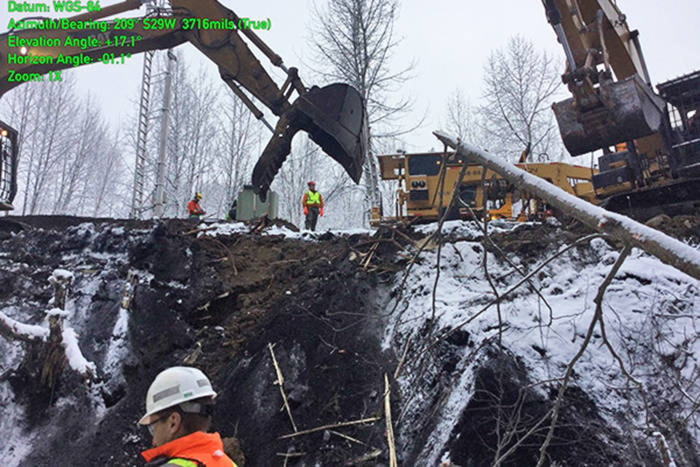The City of Terrace is reviewing its emergency response procedures to railway accidents after a resident voiced concern over the increased shipment of dangerous goods in the area.
Anne Hill gave a presentation to council on behalf of the advocacy group North West Watch on Monday, Jan. 14 on Vopak Pacific Canada’s proposal to build a bulk liquid petroleum export facility on Ridley Island near Prince Rupert.
“The lack of information available to the public about their proposal is very concerning,” Hill says.
According to Vopak project documents, the development will require an increase of 240 rail cars per day travelling through the area to B.C.’s north coast — 60 for liquefied petroleum gas, 90 for clean petroleum products, such as diesel or gasoline, and 90 for methanol.
READ MORE: Vopak expects 240 liquid gas-by-rail cars per day
As it is, 50 to 60 rail cars full of propane will be going through Terrace when the AltaGas propane export terminal, also on Ridley Island, is finished this year.
And 30 to 60 more rail cars full of propane a day could be heading south to Kitimat should an export terminal being proposed by a Vancouver company called Pacific Traverse Energy take hold.
READ MORE: Geotechnical work underway at proposed Kitimat propane terminal
All shipments will travel along CN rail tracks running directly through Terrace, separating the city into north and south sides.
“We’re looking at a potential increase of 350 rail cars per day in addition to the current rail traffic that we have,” Hill says.
In a letter to CN Rail, executive director of Skeena Wild Greg Knox also asked for a more substantial assessment.
“CN and Transport Canada has not sufficiently outlined the probability of accidents, the volatility of goods, and, most importantly, the level of risk to people and water resources,” he wrote. “The environmental assessment processes for these projects does not include rail transport of these products.”
Hill says community members’ requests to include rail transportation were denied, and potential risks to communities along the route and the watershed are not considered in Vopak’s environmental assessment report.
So far, Vopak has published a draft of their environmental review, which forms their initial approach to the process with BC Environmental Assessment over the next year.
Current volumes withheld
Hill pointed to last January’s coal train spill near Hazelton as an example of a recent derailment in the Northwest.
Knox’s letter argues that CN “did not implement a quick and efficient spill response” following the incident. The letter also describes the Lac-Mégantic disaster as “a series of mistakes” which led to Canada’s deadliest rail accident since 1867.
CN Rail vice president Doug Ryhorchuk disputed claims they were slow in their response to the coal spill. After it was reported Jan. 19, 2018, a CN spokesperson told Black Press Media that emergency response crews and environmental teams were quick on the ground to assess the situation and begin clean-up.
READ MORE: Train derails in Northwest B.C.
Since Lac-Mégantic, Ryhorchuk says Transport Canada has made changes to how they regulate the transportation of dangerous goods by rail, including lowering permitted speeds, a faster phase-out timeline for older tanker cars, more safety inspections and stronger tank car standards.
“However based on the assessment of those advocating for safer railways and because of these plans to ship more dangerous goods by rail, we know there is a lot more to be done,” Hill says.
In response to Knox’s question about the expected volumes and destinations of dangerous goods CN currently transports, CN Rail vice president Doug Ryhorchuk wrote that the information is only accessible to municipal emergency planning officials and first responders, and purposely kept confidential to “minimize risks associated with its dissemination.”
Ryhorchuk also mentioned that each of the municipalities along the railway corridor have varying first response capabilities in the event of a serious spill.
“CN’s BC Spill Contingency plan invokes an Incident Command System to facilitate the rapid mobilization of resources needed to carry out and support emergency and non-emergency response operations in respect of any spill,” the letter reads.
READ MORE: Better dangerous goods response wanted
How prepared is the City of Terrace?
However, Hill noted Transport Canada’s “heavy reliance” on municipal governments to be proactive in their response to potential spills and emergencies.
Transport Canada’s website notes “emergency response falls on the local communities jurisdiction and as such local officials are in command of response operations pertaining to the response and recovery of its residents.”
Considering all of the city’s emergency response services are located within evacuation zones and divided geographically by the CN rail yard, Hill asked what the city’s alternative plans are in the event of a serious disaster.
READ MORE: Rail safety needs improving
“I live in the blast zone. We need to have confidence in our municipal leaders that we are fully prepared to deal with unprecedented volumes of dangerous goods,” she says. “Because CN Rail will not divulge what goods are being shipped, I don’t have that confidence.”
After the presentation, Coun. Jessica McCallum Miller agreed the issue was “extremely important” and the city should be thinking about its preparedness with the “huge influx of these dangerous goods coming in.”
Mayor Carol Leclerc says the city is aware of the issue and will refer to emergency response officials to provide information on the city’s level of preparedness, possible alternative plans, and transparency of information.
brittany@terracestandard.com
Like us on Facebook and follow us on Twitter
